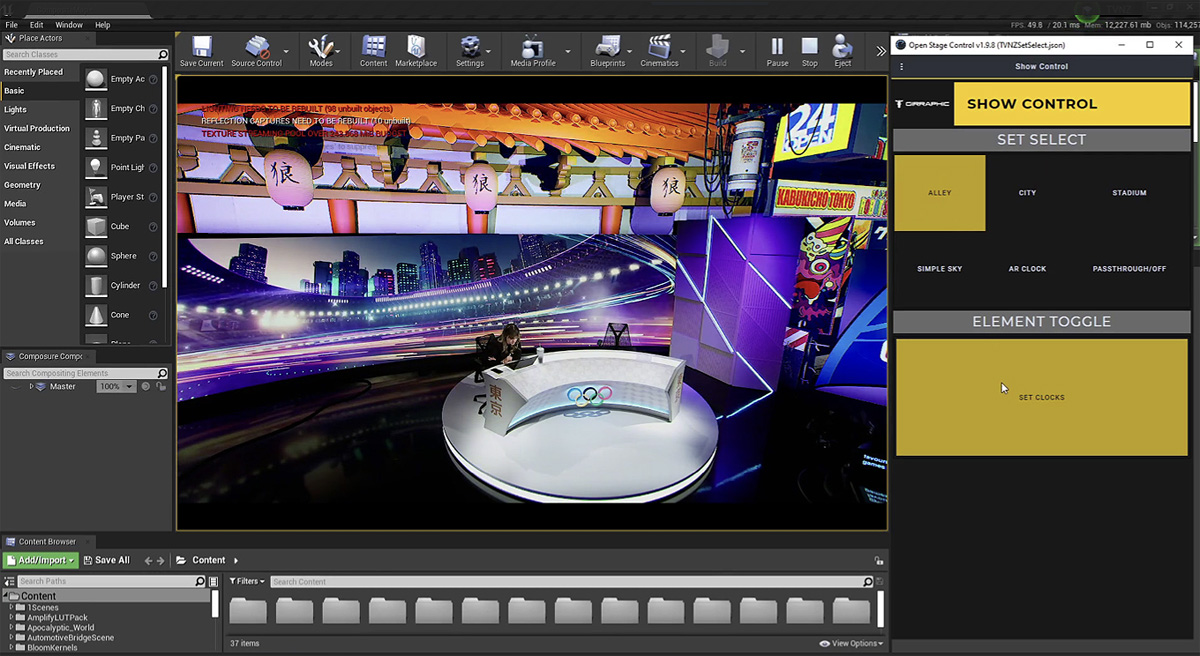Case Study: How Girraphic leveraged Unreal for unique Olympic vistas

Subscribe to NCS for the latest news, project case studies and product announcements in broadcast technology, creative design and engineering delivered to your inbox.
When we were approached by TVNZ for their 2020 Summer Olympics broadcast, we quickly realized we had the opportunity to deliver something a little beyond our normal set extension work. The original pitch was a prime candidate for pushing boundaries, a relatively low-risk integration with plenty of lead-up time, a large amount of creative freedom and an already established show aesthetic to draw inspiration from.
We were provided with four backgrounds, intended for the video wall and we extrapolated three environments that we could build that would match them. Once we knew what form these environments were going to take, we decided it was a natural fit for an Unreal Engine-based production. Unreal allows us a level of visual fidelity and complexity that we were going to need for the environments. A neon cityscape, a fog-filled alleyway and the iconic and detailed Japan National Stadium would be left wanting without Unreal to provide the life and detail required by such scenes.
The Integration itself was created entirely natively within Unreal using an in-house workflow we’ve developed over the last year.


Simplicity to operate and reliability were a necessity, as we wanted the set extension to feel as much like any other camera as possible. To this end, we tuned our integration for maximum ease of use. The set uses no greenscreen, utilizing a virtual model of the set to mask out the edges of the real-world space, and when combined with a tracked camera provides the illusion of true perspective. This allowed us to provide a rock-solid set that required no daily refinements to the mask or tweaking of a key. It was as simple as booting the engine and pressing start. We also created a simple OSC interface to allow an operator to swap between the sets at will without bringing down the feed or even interacting with Unreal itself.


The three sets dynamically load and unload, meaning that not only could they be jumped between almost instantaneously, but we could also add even more sets without impacting the performance of the others.
This methodology proved vital to the success of the project, as the NSW Lockdown prevented us from installing the set ourselves, and we were forced to troubleshoot and iterate via Remote Desktop and phone calls. A challenging environment at the best of times, made even harder by the technical complexity of the project. Despite all of this, the set went up with minimal hassle.
We couldn’t have predicted the fantastic response to the set. As soon as it was installed, it saw more and more use. What started as a sliver of skyline soon grew to encompass establishing shots and even throws between sets.


As the set was used more, we implemented more functionality to meet it. Unreal allowed us to implement complicated functionality quickly, like the AR Clocks seen on either side of the set. Not only can they be adjusted for any time zone, but they can also be toggled on and off from the operator interface. We also implemented animation to bring even more life to the scene, leading to the creation of the Team’s personal favorite interface call, the ‘Summon Godzilla’ button.


Ultimately, we couldn’t be happier with the project and the response people have had to it. We were given an opportunity to push the envelope and we’re proud of our Unreal Team for pulling it together and making it shine through the difficult circumstances we find ourselves in. We’re looking forward to using this as the baseline for our next project and push it even further.
Subscribe to NCS for the latest news, project case studies and product announcements in broadcast technology, creative design and engineering delivered to your inbox.





tags
2020 Summer Olympics, Epic Games Unreal Engine, Girraphic, new zealand
categories
Augmented Reality, Virtual Production and Virtual Sets, Case Study, Featured, Olympics, Virtual Sets, Voices